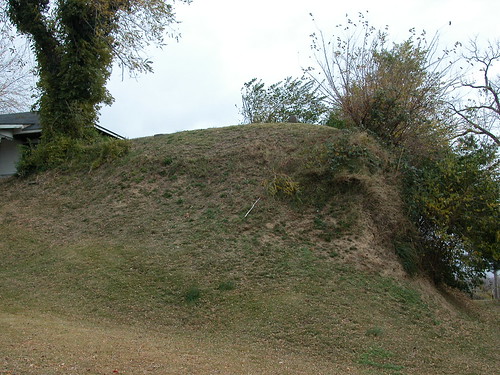 According to the office of U.S. Representative Russ Carnahan (D-3rd), the Osage Nation will purchase the property that includes Sugar Loaf Mound near I-55 and Broadway in south St. Louis. The Osage Nation plan to use the site for interpretive and educational purposes. Sugarloaf Mound is the last remaining mound in a city once nicknamed "Mound City."
According to the office of U.S. Representative Russ Carnahan (D-3rd), the Osage Nation will purchase the property that includes Sugar Loaf Mound near I-55 and Broadway in south St. Louis. The Osage Nation plan to use the site for interpretive and educational purposes. Sugarloaf Mound is the last remaining mound in a city once nicknamed "Mound City."The news brings to a close efforts to preserve the mound, which had been for sale since last year since the owner had to vacate the house on the property due to health reasons. Representative Carnahan convened a task force last year to secure a buyer that would preserve the mound and dedicate it to educational purposes. With that work done, a new chapter in the effort begins. Perhaps some day St. Louisans will be able to tour a mound site in their own city and learn about part of their built past that has been almost entirely lost.
Andrew Weil, Research associate at Landmarks Association of St. Louis, published an excellent history of the mound in November 2008: "The Last Standing Mound In Mound St. Louis City Is For Sale."
Also, filmmaker Kevin Cook made a documentary about Sugar Loaf Mound in March 2008, and it is available on YouTube in two sections included here.





4 comments:
If you ask me, they just bought a $400,000 mound of loess.
http://en.wikipedia.org/wiki/Loess
snark is for dummies, greglamb06.
thanks, alan.
Alan - I assure you I am no dummy, nor was I trying to be snarky. I believe Sugar Loaf is a wind-blown depositional feature that you find all along the Mississippi and Missouri river bluffs. Even though there are many Native American constructed mounds in the area, I haven't seen any evidence sited that shows Native Americans constructed Sugar Loaf. Native peoples may have used or even manipulated the feature but if you walk down and look at it, the material is loess. It is very susceptible to erosion thus forming the mound like shape. Take a look at the photos in the link provided and tell me they couldn't be mistaken for Indian mounds.
://www.edu.pe.ca/southernkings/loesssp.htm
I thought loess was a low land accumulation that occurs more in Nebraska and Northern MO. (obviously no geologist/civil engineer me)
if it is indeed a mound what great resolution.
Post a Comment